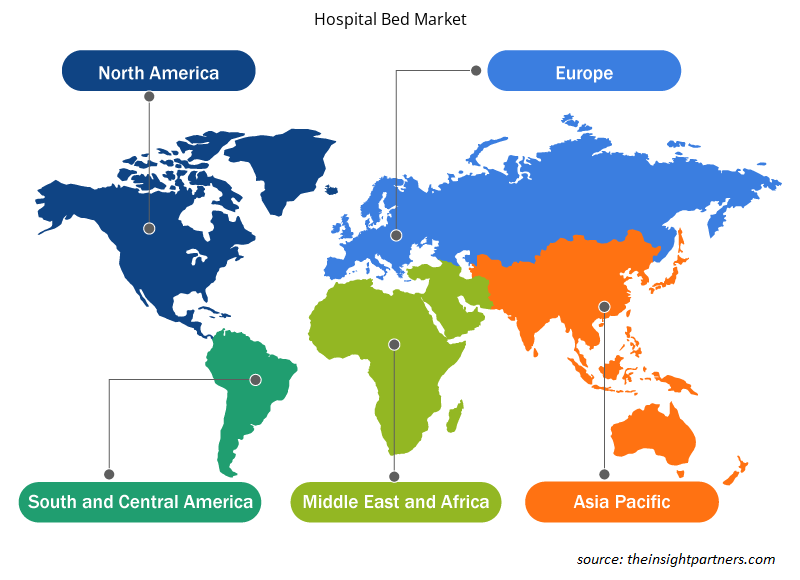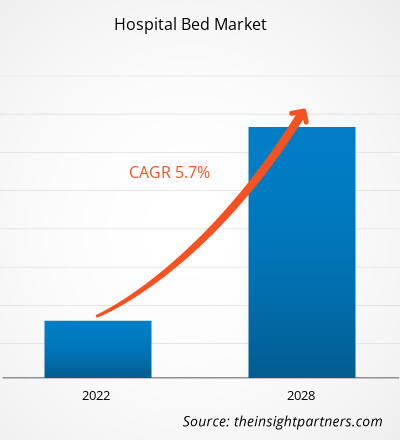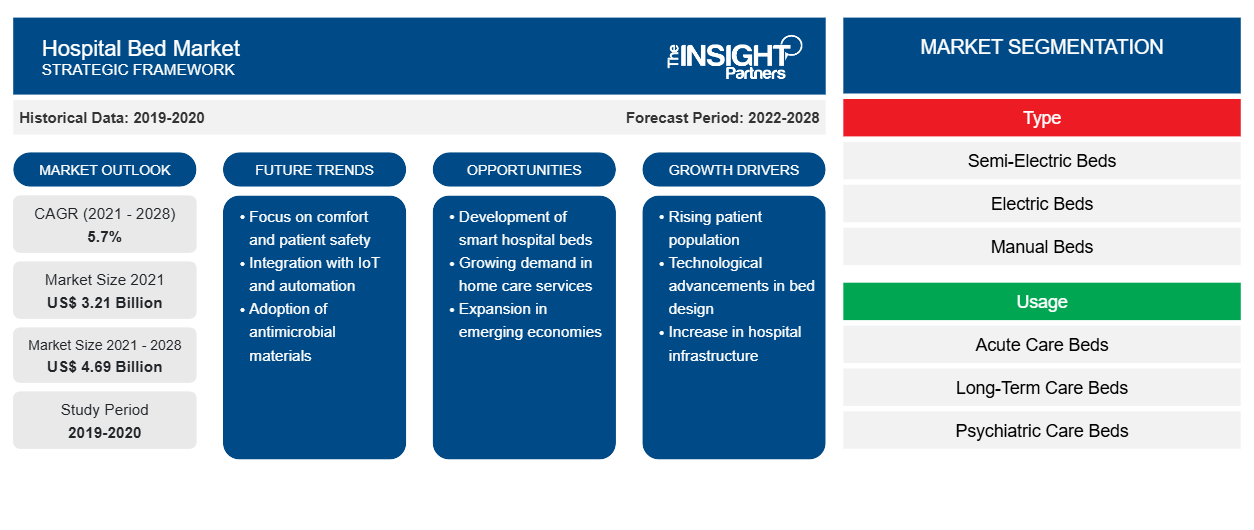Si prevede che il mercato dei letti ospedalieri crescerà da 3.214,96 milioni di dollari nel 2021 a 4.688,96 milioni di dollari entro il 2028; si stima che crescerà a un CAGR del 5,7% dal 2022 al 2028.
La crescente prevalenza di malattie croniche e la crescente preferenza per letti ospedalieri altamente attrezzati con caratteristiche innovative stanno guidando la crescita complessiva del mercato. Inoltre, i servizi di assistenza sanitaria domiciliare per la popolazione geriatrica e le cure postoperatorie offrono opportunità redditizie agli operatori del mercato.
Secondo il rapporto del National Health Council, circa 40 milioni di americani affrontano limitazioni nelle loro attività di routine perché soffrono di una o più condizioni di salute croniche. Le malattie croniche incurabili colpiscono circa 133 milioni di americani, che rappresentano oltre il 40% della popolazione totale, secondo il rapporto pubblicato nel 2019. Molte persone vivono con una o più malattie croniche, come diabete, malattie cardiache o depressione, ma con due o più condizioni. Una prevalenza così elevata di malattie croniche può comportare una maggiore necessità di ospedalizzazione, che determina la domanda di posti letto ospedalieri. Secondo le stime presentate in un rapporto del Department of Health & Children, circa l'80% delle visite dei medici di base (GP) e il 60% delle richieste di posti letto ospedalieri sono correlate a casi di malattie croniche con complicazioni associate. Secondo un rapporto della Data and Digital Health Unit, i posti letto ospedalieri per acuti sono disponibili per cure curative, pari a 100.000 posti letto per popolazione in Europa. I pazienti vengono sistemati su questi letti per gestire il travaglio (ostetricia), curare malattie non mentali o fornire trattamenti definitivi per lesioni, eseguire interventi chirurgici e alleviare i sintomi di malattie non mentali , tra gli altri. Circa il 75% della spesa sanitaria è destinata alla gestione delle malattie croniche ogni anno negli Stati Uniti. Secondo le stime fornite nel rapporto del Department of Health & Children, circa 8 delle 11 principali cause di ospedalizzazione nel Regno Unito sono associate a malattie croniche e il 5% dei pazienti ricoverati è allineato con condizioni a lungo termine, occupando circa il 42% dei letti ospedalieri.
Diabete e malattie cardiache, tra le altre condizioni croniche, sono le principali cause di morte e disabilità negli Stati Uniti. Ad esempio, nel 2019, obesità e ipertensione erano le condizioni croniche più comuni in California, che colpivano più di un adulto su quattro nello stato. Inoltre, i tassi di ricovero ospedaliero erano elevati tra le persone affette da condizioni croniche, rappresentando 700 ricoveri ospedalieri ogni 100.000 persone in California. Pertanto, la crescente prevalenza di condizioni croniche sta favorendo la crescita complessiva del mercato globale dei posti letto ospedalieri
Personalizza questo report in base alle tue esigenze
Riceverai la personalizzazione gratuita di qualsiasi report, comprese parti di questo report, o analisi a livello nazionale, pacchetto dati Excel, oltre a usufruire di grandi offerte e sconti per start-up e università
-
Scopri le principali tendenze di mercato in questo rapporto.Questo campione GRATUITO includerà analisi di dati che spaziano dalle tendenze di mercato alle stime e alle previsioni.
Le piaghe da decubito o le piaghe da pressione associate al letto ospedaliero rappresentano un importante freno per il mercato dei letti ospedalieri. Secondo un rapporto del NIH, l'ulcera da decubito è un problema comune e serio tra i pazienti ricoverati che giacciono sui letti ospedalieri per lunghi periodi . Ad esempio, se un paziente è in modalità sonno per un lungo periodo e la pressione del suo peso corporeo supera un certo punto, si verificano lividi e ferite incurabili. Pertanto, il personale ospedaliero deve ruotare regolarmente questi pazienti sui loro letti per prevenire la formazione di ulcere. Le piaghe da decubito sono al terzo posto tra i disturbi più costosi, dopo il cancro e le malattie cardiovascolari a livello globale. Ad esempio, secondo le stime fornite nel rapporto del NIH, le ferite da decubito colpiscono più di 3 milioni di adulti a livello globale. Inoltre, le strutture di terapia intensiva e di riabilitazione a lungo termine lottano con i rischi associati alle piaghe da decubito tra i ricoveri ospedalieri. Ad esempio, come affermato nel rapporto di NursingHomeAbuseGuide.org , negli Stati Uniti nei prossimi anni non meno di 150.000 pazienti o residenti soffriranno di piaghe da decubito (in alcuni stadi).
Panoramica regionale
L'Europa detiene la quota maggiore del mercato globale dei posti letto ospedalieri. Tra gli Stati membri dell'UE, la Germania registra il numero più elevato di posti letto ospedalieri, con ricavi e crescita considerevoli. I recenti dati OCSE 2020 confermano che la Germania ha il numero più elevato di posti letto in terapia intensiva. Prima dell'inizio della pandemia, la Germania aveva 28.000 posti letto in terapia intensiva, ovvero più della maggior parte dei paesi limitrofi. Durante la prima ondata pandemica di SARS-CoV-2 (al 18 aprile 2020), 12.336 posti letto in terapia intensiva (o il 41% della capacità disponibile di posti letto in terapia intensiva) erano ancora vacanti nel paese. Per gestire questa crisi sanitaria, il governo tedesco ha enfatizzato la prevenzione primaria e secondaria e l'aggiunta di posti letto alla capacità di terapia intensiva esistente è stata intrapresa come misura di prevenzione terziaria. Il governo tedesco ha aggiunto circa 7.000 posti letto al 27 aprile 2020. Si prevede che il mercato dei posti letto ospedalieri nel Regno Unito crescerà con il crescente numero di interventi chirurgici, tra cui interventi chirurgici cardiaci, ortopedici e traumatologici.
Informazioni basate sul tipo
In base al tipo, il mercato globale dei letti ospedalieri è suddiviso in semi-elettrici, elettrici e manuali. Si stima che il segmento dei letti elettrici registrerà il CAGR più elevato dal 2022 al 2028. I letti elettrici stanno guadagnando molta popolarità sul mercato. Questi letti sono inoltre dotati di una funzione di massaggio terapeutico opzionale per i pazienti costretti a letto, gestita tramite telecomando, che aiuta la circolazione e aiuta a prevenire piaghe da decubito e dolori articolari. La funzione è abilitata come caratteristica integrata nel materasso. Inoltre, gli operatori sanitari e i pazienti non devono effettuare frequenti regolazioni o preoccuparsi di perdere supporto durante la notte. Ad agosto 2022, l'ospedale Hāwera ha acquistato 20 nuovi letti dalla gamma M9 di Howard Wright, un progettista e produttore di letti medici con sede a Taranaki . Con l'aiuto di questi letti, il personale ospedaliero ha potuto far sentire i pazienti più a loro agio, eliminando la necessità di sollevarli. I letti M9 forniscono controlli elettrici completi per le loro regolazioni a varie altezze e posizioni. Tra gli altri letti elettrici ospedalieri disponibili sul mercato figurano Zenith9100, Invacare Full-Electric Homecare Bed e la gamma DELTA 4.
Le aziende che operano nel mercato globale dei letti ospedalieri adottano una strategia di innovazione di prodotto per soddisfare le mutevoli esigenze dei clienti in tutto il mondo, il che consente loro anche di mantenere il proprio marchio sul mercato.
Approfondimenti regionali sul mercato dei letti ospedalieri
Le tendenze regionali e i fattori che influenzano il mercato dei letti ospedalieri durante il periodo di previsione sono stati ampiamente spiegati dagli analisti di Insight Partners. Questa sezione discute anche i segmenti e la geografia del mercato dei letti ospedalieri in Nord America, Europa, Asia Pacifico, Medio Oriente e Africa e Sud e Centro America.

- Ottieni i dati specifici regionali per il mercato dei letti ospedalieri
Ambito del rapporto sul mercato dei letti ospedalieri
| Attributo del report | Dettagli |
|---|---|
| Dimensioni del mercato nel 2021 | 3,21 miliardi di dollari USA |
| Dimensioni del mercato entro il 2028 | 4,69 miliardi di dollari USA |
| CAGR globale (2021 - 2028) | 5,7% |
| Dati storici | 2019-2020 |
| Periodo di previsione | 2022-2028 |
| Segmenti coperti |
Per tipoType
|
| Regioni e Paesi coperti |
America del NordAmerica
|
| Leader di mercato e profili aziendali chiave |
|
Densità dei giocatori del mercato dei posti letto ospedalieri: comprendere il suo impatto sulle dinamiche aziendali
Il mercato dei letti ospedalieri sta crescendo rapidamente, spinto dalla crescente domanda degli utenti finali dovuta a fattori quali l'evoluzione delle preferenze dei consumatori, i progressi tecnologici e una maggiore consapevolezza dei vantaggi del prodotto. Con l'aumento della domanda, le aziende stanno ampliando le loro offerte, innovando per soddisfare le esigenze dei consumatori e capitalizzando sulle tendenze emergenti, il che alimenta ulteriormente la crescita del mercato.
La densità degli operatori di mercato si riferisce alla distribuzione di aziende o società che operano in un particolare mercato o settore. Indica quanti concorrenti (operatori di mercato) sono presenti in un dato spazio di mercato in relazione alle sue dimensioni o al valore di mercato totale.
Le principali aziende che operano nel mercato dei letti ospedalieri sono:
- Società per azioni Hill-Rom Holdings, Inc.
- Stryker
- Arjo
- Società Invacare
- PARAMOUNT BED CO., LTD.
Disclaimer : le aziende elencate sopra non sono classificate secondo un ordine particolare.

- Ottieni una panoramica dei principali attori del mercato dei letti ospedalieri
Mercato globale dei letti ospedalieri – Segmentazione
In base al tipo, il mercato globale dei letti ospedalieri è suddiviso in letti semi-elettrici, letti elettrici e letti manuali. Il segmento dei letti semi-elettrici ha rappresentato la quota di mercato maggiore nel 2021. Tuttavia, il segmento dei letti elettrici ha registrato il CAGR più elevato dal 2022 al 2028. In base all'utilizzo, il mercato globale dei letti ospedalieri è suddiviso in letti per terapia intensiva, letti per cure a lungo termine, letti per cure psichiatriche e altri. Il segmento dei letti per terapia intensiva ha guidato il mercato nel 2021 e si prevede che manterrà il suo predominio durante il periodo di previsione. In base all'applicazione, il mercato globale dei letti ospedalieri è suddiviso in letti per terapia non intensiva e letti per terapia intensiva. Il segmento dei letti per terapia non intensiva ha guidato il mercato nel 2021 e si prevede che manterrà il suo predominio durante il periodo di previsione. In base all'utente finale, il mercato è suddiviso in ospedali e cliniche, strutture di assistenza agli anziani, centri chirurgici ambulatoriali e strutture di assistenza domiciliare. In base all'area geografica, il mercato globale dei letti ospedalieri è suddiviso principalmente in Nord America, Europa, Asia Pacifico, Medio Oriente e Africa, America meridionale e centrale.
Profili aziendali
- Società per azioni Hill-Rom Holdings, Inc.
- Stryker
- Arjo
- Società Invacare
- PARAMOUNT BED CO., LTD.
- Prodotti per la salute GF, Inc.
- Malvestio SpA
- Span America (Savaria Corporation)
- Industrie di salvezza
- Stiegelmever GmbH & Co. KG è un'azienda tedesca specializzata nella produzione di articoli per la cura della persona.
- Medstrom
- Analisi storica (2 anni), anno base, previsione (7 anni) con CAGR
- Analisi PEST e SWOT
- Valore/volume delle dimensioni del mercato - Globale, Regionale, Nazionale
- Industria e panorama competitivo
- Set di dati Excel
Report recenti
Rapporti correlati
Testimonianze
Motivo dell'acquisto
- Processo decisionale informato
- Comprensione delle dinamiche di mercato
- Analisi competitiva
- Analisi dei clienti
- Previsioni di mercato
- Mitigazione del rischio
- Pianificazione strategica
- Giustificazione degli investimenti
- Identificazione dei mercati emergenti
- Miglioramento delle strategie di marketing
- Aumento dell'efficienza operativa
- Allineamento alle tendenze normative























 Ottieni un campione gratuito per - Mercato dei letti ospedalieri
Ottieni un campione gratuito per - Mercato dei letti ospedalieri